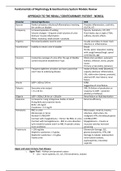Emory University School Of Medicine
Latest uploads at Emory University School Of Medicine. Looking for notes at Emory University School Of Medicine? We have lots of notes, study guides and study notes available for your school.
-
19
- 0
-
2
All courses for Emory University School Of Medicine
Latest notes & summaries Emory University School Of Medicine
Fluid and Electrolytes - 17 questions (# in parenthesis next to objective) Objectives: 1. Identify body fluid compartments and summarize the movement of fluids (and electrolytes) throughout the compartments (1) - Hydrostatic Pressure (Capillary Filtration) - highest at arterial end (30 mmHg), lowest at venous (10 mmHg) - Colloidal Osmotic Pressure (Capillary Oncotic) - highest at venous end (28 mmHg) - Interstitial hydrostatic pressure - pushes fluid back into capillary - Interstitial...
Fluid and Electrolytes - 17 questions (# in parenthesis next to objective) Objectives: 1. Identify body fluid compartments and summarize the movement of fluids (and electrolytes) throughout the compartments (1) - Hydrostatic Pressure (Capillary Filtration) - highest at arterial end (30 mmHg), lowest at venous (10 mmHg) - Colloidal Osmotic Pressure (Capillary Oncotic) - highest at venous end (28 mmHg) - Interstitial hydrostatic pressure - pushes fluid back into capillary - Interstitial...
Name: Date: Student Exploration: Coulomb Force (Static) Directions: Follow the instructions to go through the simulation. Respond to the questions and prompts in the orange boxes. Vocabulary: Coulomb’s law, electrostatic force, vector Prior Knowledge Questions (Do these BEFORE using the Gizmo.). Have you ever taken clothes out of the dryer and found a sock stuck to your underwear? Static cling is an example of electrostatic forces, or the forces that exist between charged objects. 1. How do yo...
A nurse is reinforcing teaching with a client who reports right shoulder pain following a laparoscopic cholecystectomy. Which of the following statements should the nurse make? 1) "The pain results from lying in one position too long during surgery." 2) "The pain occurs as a residual pain from cholecystitis." 3) "The pain will dissipate if you ambulate frequently." 4) "The pain is caused from the nitrous dioxide injected into the abdomen."
28. How much hydrochloric acid (HCl) is necessary to make 2.5 liters ofa 5:1 solution of water (in liters) to HCl (in grams)? A. 0.5 grams B. 2 grams C. 5 grams D. 12.5 grams
Renal GU Module PA Didactic
Emory Pediatrics Module Didactic PA
Ortho Rheum Midterm Module PA Didactic
Ortho Rheum Module PA Didactic
GI Midterm Module Didactic PA










